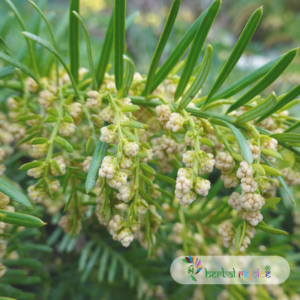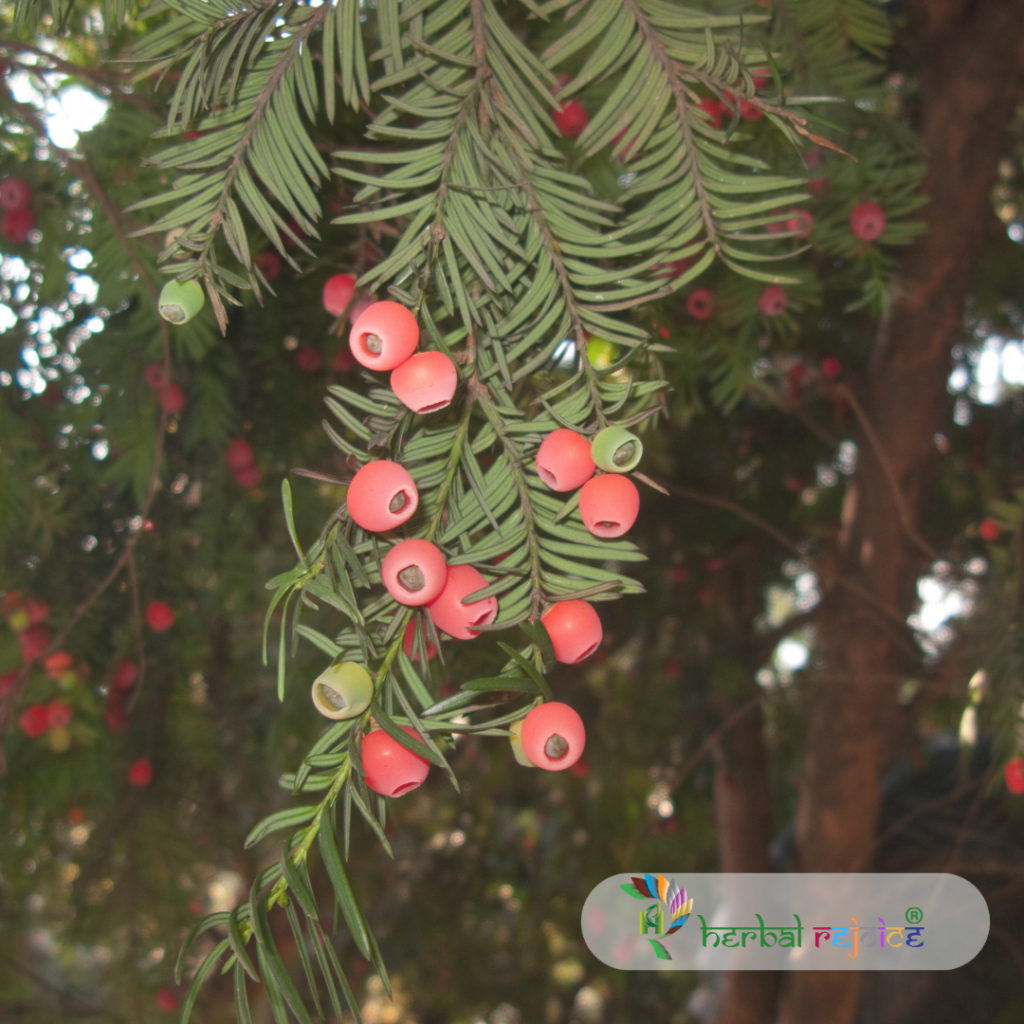Introduction
Taxus baccata Linn., commonly known as European Yew, is a tree species that belongs to the Taxaceae family. It is found in the Temperate Himalayas, Khasi Hills, and Manipur. The Himalayan Yew, also referred to as Taxus wallichiana Zucc., is considered synonymous with Taxus baccata Linn. subspecies wallichiana (Zucc.) Pilgoe and Taxus baccata Hook. f.
In Ayurveda, this plant is known by various names such as Thunera, Sthauneya, Sthauneyaka, Shukapushpa, Dhaatri-patra, and Vikarna. It is important to note that it is not a substitute for Taalisapatra. In Unani medicine, it is called Zarnab, and in Siddha/Tamil medicine, it is known as Taaleespatri Bhedam. In folklore, it is commonly referred to as Birmi or Thuno.
Therauptic Properties
Taxus baccata Linn. has several medicinal actions. It acts as a central nervous system (CNS) depressant and reduces motor activity. It also exhibits analgesic and anticonvulsant properties. The leaves of this plant are used in the treatment of nervousness, epilepsy, hysteria, asthma, and chronic bronchitis. Both the leaves and fruits of Taxus baccata Linn. possess antispasmodic, sedative, and emmenagogue effects.

Chemical Components
The berries of this plant are specifically used in the treatment of chronic bronchitis. Moreover, Taxol, a compound found in Taxus baccata Linn., has been found to have antimitotic properties. It is currently being studied for its potential use in the treatment of severe drug-resistant human malaria. The content of taxol in Himalayan Yew varies with season and location, ranging from 0.045% to 0.130%.
In addition to taxol, the needles of Taxus baccata Linn. contain diterpene esters of taxane-type, collectively known as taxine (0.6-2.0%). Taxine consists of 11 compounds, with taxine A and B being the only characterized compounds. Taxol, the diterpene amide found in Taxus baccata Linn., has shown activity against ovarian cancer in humans, with response rates of 24-30% in clinical studies. However, the ester alkaloids present in higher doses can be cardiotoxic.
The dried needles of Taxus baccata Linn. contain various phytochemicals, including biflavonoids (such as sotetsuflavone, sequoiflavone, sciadopitysin, ginkgetin, kayaflavone, and amentoflavone), beta-sitosterol, heptacosanol, and surcose. Additionally, the needles contain several phenolics.
Betuloside, a compound found in rhododendron, has been shown to possess hepatoprotective activity against hepatotoxins in rats. It is important to note that the seeds of Taxus baccata Linn. are poisonous and contain taxine.
Studies have shown that the aqueous extract of the leaves of Taxus baccata Linn. exhibits a depressant effect on the central nervous system in rats. The Ayurvedic Pharmacopoeia of India attributes various properties to the dried needles of Himalayan Yew, including antirheumatic, anticatarrhal, insecticidal, and wound-healing properties.
Dosage
It suggests the use of the powdered form of the drug (1-3 g) for disorders related to vitiated blood, tumors, dermatosis, and helminthiasis.The recommended dosage of Taxus baccata Linn. varies depending on the part of the plant used. For the leaves, the recommended dosage is 1-3 g in powder form. In the case of the leaf bark, the recommended dosage is 3-5 g in powder form according to the Ayurvedic Pharmacopoeia of India.
Conclusion
In conclusion, Taxus baccata Linn., also known as European Yew, is a tree species found in the Temperate Himalayas, Khasi Hills, and Manipur. It possesses various medicinal actions and is used in the treatment of nervousness, epilepsy, hysteria, asthma, chronic bronchitis, and other disorders. It contains compounds such as taxol and taxine, which have shown potential in the treatment of ovarian cancer and drug-resistant malaria. However, it is important to note that some compounds present in Taxus baccata Linn. can be cardiotoxic and its seeds are poisonous. The recommended dosages vary depending on the part of the plant used.
Frequently Asked Questions
What is Taxus baccata Linn.?
Taxus baccata Linn. is a tree species commonly known as European Yew.
Where is Taxus baccata Linn. found?
Taxus baccata Linn. is found in the Temperate Himalayas, Khasi Hills, and Manipur.
What are the medicinal properties of Taxus baccata Linn.?
Taxus baccata Linn. has medicinal properties such as being a central nervous system (CNS) depressant, reducing motor activity, and exhibiting analgesic and anticonvulsant effects.
What are the uses of Taxus baccata Linn. in traditional medicine?
Taxus baccata Linn. is used in the treatment of nervousness, epilepsy, hysteria, asthma, chronic bronchitis, and other related disorders.
What are the active compounds present in Taxus baccata Linn.?
Taxus baccata Linn. contains compounds such as taxol and taxine.
What is taxol?
Taxol is a compound found in Taxus baccata Linn. that has shown potential in the treatment of ovarian cancer and drug-resistant malaria.
Are there any side effects of Taxus baccata Linn.?
The ester alkaloids present in higher doses can be cardiotoxic.
Can Taxus baccata Linn. be used for hepatoprotection?
No, Taxus baccata Linn. is not traditionally used for hepatoprotection.
Can the seeds of Taxus baccata Linn. be eaten?
No, the seeds of Taxus baccata Linn. are poisonous and should not be consumed.
What are the recommended dosages of Taxus baccata Linn.?
The recommended dosage of Taxus baccata Linn. varies depending on the part of the plant used.
What are the recommended dosages for the leaves of Taxus baccata Linn.?
The recommended dosage for the leaves is 1-3 g in powdered form.
What are the recommended dosages for the leaf bark of Taxus baccata Linn.?
The recommended dosage for the leaf bark is 3-5 g in powdered form.
Can Taxus baccata Linn. treat ovarian cancer?
Taxol, a compound found in Taxus baccata Linn., has shown activity against ovarian cancer in humans, with response rates of 24-30% in clinical studies.
Can Taxus baccata Linn. be used for the treatment of malaria?
Taxol, found in Taxus baccata Linn., is currently being studied for its potential use in the treatment of severe drug-resistant human malaria.
What are the names of Taxus baccata Linn. in Ayurveda?
Taxus baccata Linn. is known by various names in Ayurveda such as Thunera, Sthauneya, Sthauneyaka, Shukapushpa, Dhaatri-patra, and Vikarna.
What is the toxicity level of Taxus baccata Linn.?
The seeds of Taxus baccata Linn. are poisonous and can be toxic if ingested.
Are there any specific uses for the berries of Taxus baccata Linn.?
The berries of Taxus baccata Linn. are specifically used in the treatment of chronic bronchitis.
What are the phytochemicals present in Taxus baccata Linn.?
Phytochemicals found in Taxus baccata Linn. include biflavonoids, beta-sitosterol, heptacosanol, and sucrose.
Does Taxus baccata Linn. have any insecticidal properties?
According to the Ayurvedic Pharmacopoeia of India, Taxus baccata Linn. has insecticidal properties.
Can Taxus baccata Linn. be used for wound healing?
According to the Ayurvedic Pharmacopoeia of India, Taxus baccata Linn. has wound healing properties.


